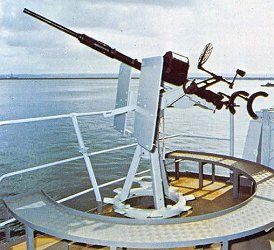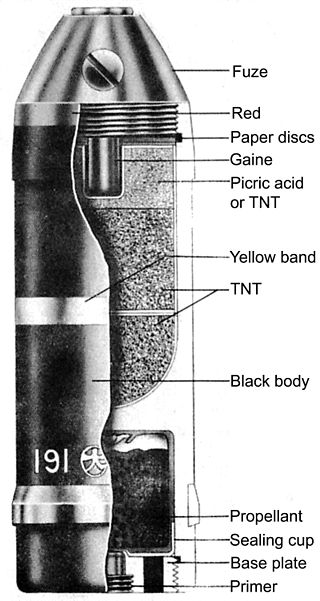Related Research Articles

The StG 44 is a German assault rifle developed during World War II by Hugo Schmeisser. It is also known by its early designations as the MP 43 and MP 44. The StG 44 was an improvement of an earlier design, the Maschinenkarabiner 42(H).

The MK 108 is a 30 mm caliber autocannon manufactured in Germany during World War II by Rheinmetall‑Borsig for use in aircraft.

The Maschinengewehr (MG) 151 is a belt-fed autocannon for aircraft use, developed in Nazi Germany from 1934 to 1940 and produced by Waffenfabrik Mauser during World War II. It was originally produced in 15.1 mm caliber from 1940, with a 15×96mm cartridge, but due to demand for higher effect against aircraft, especially with the introduction of mine shells for the 20 mm MG-FF/M aircraft cannon, the design was rechambered to 20 mm caliber in 1941, using a newly developed 20×82mm cartridge which traded projectile velocity for explosive power. The initial 15 mm variant then became known as the MG 151/15, with the new 20 mm variant becoming the MG 151/20.

The repeating crossbow, also known as the repeater crossbow, and the Zhuge crossbow due to its association with the Three Kingdoms-era strategist Zhuge Liang (181–234 AD), is a crossbow invented during the Warring States period in China that combined the bow spanning, bolt placing, and shooting actions into one motion.

A revolver cannon is a type of autocannon, commonly used as an aircraft gun. It uses a cylinder with multiple chambers, similar to those of a revolver handgun, to speed up the loading-firing-ejection cycle. Some examples are also power-driven, to further speed the loading process. Unlike a rotary cannon, a revolver cannon only has a single barrel, so its spun weight is lower. Automatic revolver cannons have been produced by many different manufacturers.
Blowback is a system of operation for self-loading firearms that obtains energy from the motion of the cartridge case as it is pushed to the rear by expanding gas created by the ignition of the propellant charge.

The Vickers 40 mm Class S gun, also known simply as the Vickers S or S gun, was a 40 mm (1.57 in) airborne autocannon designed by Vickers-Armstrongs for use as aircraft armament.
The Type 97 automatic cannon is a 20-millimeter (0.79 in) Japanese anti-tank rifle that began development in the 1930s. It was used by the Imperial Japanese Army (IJA) during the Second Sino-Japanese War, the Soviet–Japanese border conflicts and the Pacific War. Improvements in armour thicknesses on tanks rendered the Type 97 obsolete by about 1942. This weapon was not related to the Type 97 heavy tank machine gun used in armored vehicles or the Type 97 aircraft machine gun used in Japanese Navy aircraft.

The Oerlikon 20 mm cannon is a series of autocannons based on an original German Becker Type M2 20 mm cannon design that appeared very early in World War I. It was widely produced by Oerlikon Contraves and others, with various models employed by both Allied and Axis forces during World War II. Many versions of the cannon are still used.

The Ho-301 was a Japanese 40 millimeter caliber autocannon that saw limited use during World War II, on Japanese Army Nakajima Ki-44 and Kawasaki Ki-45 KAI aircraft. It was unusual in using caseless ammunition. Although the effective range of the cannon was only 150 meters (490 ft), the Ho-301 was light and rapid-firing for its caliber.

The Type 3 13 mm fixed aircraft machine gun was a Japanese Navy aircraft machine gun used during World War II. It was based on the American M2 Browning machine gun but used the 13.2x99mm Hotchkiss cartridge.
Breda-SAFAT was an Italian weapons manufacturer of the 1930s and 1940s that designed and produced a range of machine-guns and cannon primarily for use in aircraft. Based on the M1919 Browning machine gun, the Italian guns were chambered to fire indigenous ammunition with 7.7 mm (0.303 in) and 12.7 mm (0.500 in) calibres, predominantly ball, tracer for the 7.7mm, including high explosive incendiary tracer (HEI-T), or armour-piercing (AP) for the 12.7mm.

The Parabellum MG 14 was a 7.92 mm caliber World War I machine gun built by Deutsche Waffen und Munitionsfabriken. It was a redesign of the Maschinengewehr 08 machine gun system intended for use on aircraft and zeppelins. Like the earlier Vickers machine gun, it used a toggle action that broke upwards rather than downwards, the opposite way to the MG 08, making for a much more compact receiver. The fusee spring was replaced with an internal spring design, the breech block was completely different and the spent cartridges dropped out the bottom of the receiver, rather than being ejected forward through a hole under the breech from the receiver. There appear to be no action or receiver parts interchangeable with the MG 08. The MG 08's belt-style ammunition feed was enclosed in a drum, the recoil casing was lightened and the cooling jacket was modified for air- instead of water-cooling. The rate of fire was 700 rounds/minute. The belt was reduced to 30 mm in width.

The Becker Type M2 20 mm cannon was a German autocannon developed for aircraft use during World War I by Stahlwerke Becker. It was first mass-produced in 1916 and was installed in a variety of aircraft. It was the only German autocannon to see service in the air during the war.
The 37 mm Automatic Gun, M4, known as the T9 during development, was a 37 mm (1.46 in) recoil-operated autocannon designed by Browning Arms Company and entered service in 1942. The M4 and its variants would primarily be manufactured by Colt's Manufacturing Company and Oldsmobile and is therefore sometimes referred to as the "Colt M4" or "Oldsmobile M4." It was primarily mounted in the Bell P-39 Airacobra and P-63 Kingcobra, with the U.S. Navy also utilizing it on many PT boats.

The Bordkanone 3,7 was a German 3.7 cm (1.46 in) anti-tank/bomber autocannon of World War II and based on the earlier 3.7 cm (1.46 in) 3.7 cm Flak 18 made by Rheinmetall.

The Short N.3 Cromarty was a prototype British twin-engined biplane flying boat, designed towards the end of the First World War. Only a single example was built, which first flew in 1921 and was wrecked in 1922.
The Nudelman-Suranov NS-45 was an enlarged version of the Soviet Nudelman-Suranov NS-37 aircraft autocannon. It was evaluated for service on 44 Yakovlev Yak-9K aircraft during World War II, but proved to stress the airframes too much. The NS-45 was also mounted on the prototype Tupolev Tu-1 night fighter after the end of World War II.

The 3.7 cm Flak M42 was the marine version of the 3.7-centimetre (1.5 in) Flak 36/37 and used by the Kriegsmarine on surface ships and as the M42U on Type VII and Type IX U-boats. The 3.7 cm Flak M42U used several types of mounts and entered service in autumn 1943.

The 3.7 cm Flak 43 was a light anti-aircraft (AA) gun used by Nazi Germany during World War II. It was derived from the 3.7-centimeter (1.5 in) Flak 18/36/37 series of AA guns. It was provided with single- and twin-gun mounts, the latter being designated as the 3.7 cm Flak 43 Zwilling and was in service from 1944 to 1945. In addition to versions used by the Kriegsmarine, it served as the main armament of the Ostwind and Möbelwagen and was proposed for use in the Flakpanzer Coelian self-propelled AA guns.
References
- 1 2 Williams, Anthony G. (2000). Rapid Fire. Airlife Publishing. p. 248. ISBN 1840371226.
- ↑ Williams, Anthony G. (2000). Rapid Fire. Airlife Publishing. p. 191. ISBN 1840371226.